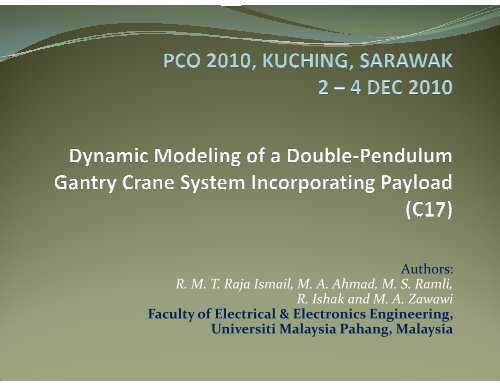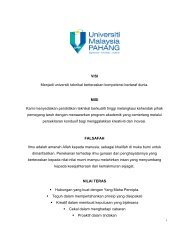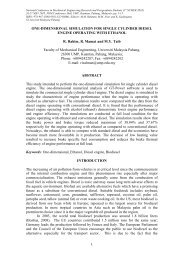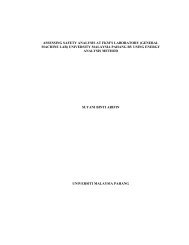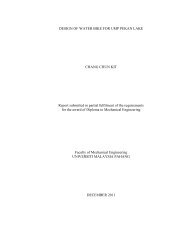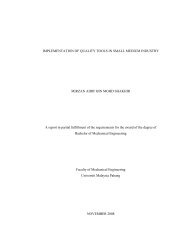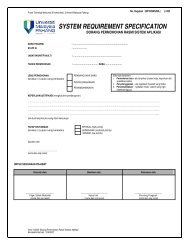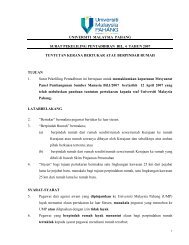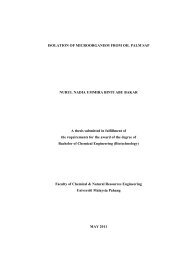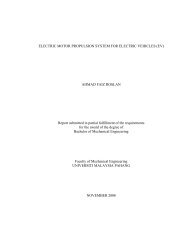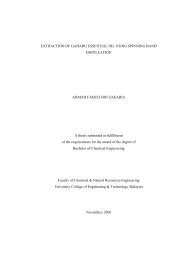PDF (Mohd Anwar Zawawi) - Universiti Malaysia Pahang
PDF (Mohd Anwar Zawawi) - Universiti Malaysia Pahang
PDF (Mohd Anwar Zawawi) - Universiti Malaysia Pahang
Create successful ePaper yourself
Turn your PDF publications into a flip-book with our unique Google optimized e-Paper software.
ABSTRACT• This paper presents dynamic modelling of a doublependulumgantry crane system based on closed-formequations of motion.• A dynamic model of the system incorporating payload isdeveloped and the effects of payload on the response ofthe system are discussed.• Extensive results that validate the theoretical derivationare presented in the time and frequency domains.
PROBLEM STATEMENT• Purpose of controlling a gantry crane:• To transport the load at short period of time (fast) withoutcausing any excessive swing at the final position.• Problems that arise:• Gantry crane results in a swing motion when the payload• Gantry crane results in a swing motion when the payloadstops suddenly after a fast rope movement.• It requires more time (larger settling time) to minimize theswing motion (swing angle).• The needs for skillful operators to manually control andstop the swing at the right position** Failure to control the crane might cause accident and mayharm people and surrounding.
BRIEFING ON Gantry Crane Sys :Model structure• The double-pendulum gantry crane system with its hookand load considered in this work is shown below.• Where x is the cart position, m c is the cart mass, m h is thehook mass and m p is the payload mass.• Meanwhile, θ 1 is the hookswing angle, θ 2 is the loadswing angle, l 1 and l 2 arethe cable length of thehook and load,respectively, and F is thecart drive force.
BRIEFING ON Gantry Crane Sys :System’s variable concernedSymbol Variable The importancex (m) Cart position To achieve steady stateposition with minimum errorθ 1 (rad) Hook swing angle To avoid excessive swing athookθ 2 (rad) Load swing angle To avoid excessive swing atPSD of θ 1(dB)PSD of θ 2(dB)Power spectral densityof the hook swinganglePower spectral densityof the load swing angleloadTo minimize the vibration athook due to rope movementTo minimize the vibration atload due to rope movement
BRIEFING ON Gantry Crane Sys :Other parameters assumption1) Cart friction force is ignored.2) The tension force that may cause the hook and loadcables elongate is also ignored.3) The cart (translational) and the payload (rotational) are3) The cart (translational) and the payload (rotational) areassumed to move in two dimensional only (2D –movements)
BRIEFING ON Gantry Crane Sys :Mathematical model1) The dynamic model of the double-pendulum gantrycrane system is expressed as :Where:Fqqqqqq )G(),C()(MWhere:)cos(cos)(cos)(cos)()M(212122211111llmlmlmmlmmlmmmmmppphphphphcq22212122)cos(coslmllmlmppp12121111)sin(000sin)(0),C(llmlmmpphqq0)sin(sin12121222llmlmpp2211sinsin)(0)G(glmglmmpphqInertia Centrifugalcoriolis Gravity
SIMULATION RESULTS …(2)0.8Hook swing angle (rad)0.60.40.20-0.2-0.4mp = 1 kgmp = 5 kgmp = 10 kgLoad swing angle (rad)10.80.60.40.20-0.2-0.4-0.6mp = 1 kgmp = 5 kgmp = 10 kg-0.6-0.8-0.80 2 4 6 8 10 12 14 16 18 20Time (s)-10 2 4 6 8 10 12 14 16 18 20Time (s)Fig 2(a): Response of the hook swing angle (m p = 1, 3, & 5 kg) Fig 2(b): Response of the load swing angle (m p = 1, 3, & 5 kg)• It is shown that, the hook swing angle and load swing angleresponses for various payloads requires more than 20 sec. tosettle down.• Besides that, it can be seen the oscillations of the hook swingangle and the load swing angle decrease with increasingpayloads.
SIMULATION RESULTS …(3)PSD of the hook swing angle (dB)3020100-10-20-30-40-50mp = 1 kgmp = 5 kgmp = 10 kgPSD of the load swing angle (dB)3020100-10-20-30-40-50mp = 1 kgmp = 5 kgmp = 10 kg-60-60-70-70-800 0.5 1 1.5 2 2.5 3 3.5 4 4.5 5Frequency (Hz)-800 0.5 1 1.5 2 2.5 3 3.5 4 4.5 5Frequency (Hz)Fig 3(a): PSD of the hook swing angle (m p = 1, 3, & 5 kg) Fig 3(b): PSD of the load swing angle (m p = 1, 3, & 5 kg)• Fig. 3 (a),(b) demonstrates that the resonance modes ofvibration of the system shift to higher frequencies withincreasing payloads.
ANALYSIS AND DISCUSSIONTable 1: Payload vs. Cart position responsesPayload(kg)Average cartposition (m)Oscillation(m)0 - -1 1.9920 ±0.36302 1.9151 ±0.38313 1.9145 ±0.42284 1.8521 ±0.49295 1.8419 ±0.50496 1.7219 ±0.50577 1.6940 ±0.50758 1.6063 ±0.50919 1.5472 ±0.510010 1.5154 ±0.5102Table 2: Payload vs. Hook & load swing anglesPayload(kg)Hook swingangle (°)Load swingangle (°)0 - -1 ±0.4132 ±0.88262 ±0.4063 ±0.74183 ±0.3770 ±0.61404 ±0.3493 ±0.53195 ±0.3080 ±0.39826 ±0.3049 ±0.37917 ±0.2919 ±0.34318 ±0.2813 ±0.32449 ±0.2333 ±0.300710 ±0.2305 ±0.2902• From table 1, the average cart position decreases but theoscillation itself increases for heavier loads.• Meanwhile, both hook and load swing angle decreasewith the load increments (Refer table 2)
ANALYSIS AND DISCUSSIONTable 3: Payload vs. Hook & load swing angles resonanse freq. (Hz)Resonance frequency (Hz)PayloadHook swing angle Load swing angle(kg)Mode 1 Mode 2 Mode 1 Mode 20 - - - -1 0.3662 1.343 0.3662 1.0992 0.3662 1.587 0.3662 1.2213 0.3662 1.709 0.3662 1.2214 0.3662 1.709 0.3662 1.2215 0.4883 1.099 0.4883 1.2216 0.4883 1.221 0.4883 1.2217 0.4883 1.343 0.4883 1.3438 0.4883 1.343 0.4883 1.3439 0.4883 1.465 0.4883 1.46510 0.4883 1.465 0.4883 1.465• From table 3, it shows that both hook and load swingangles have the same resonance frequencies of mode 1.• It is due to the sway of the payload is always follow theoscillation of the hook.
ANALYSIS AND DISCUSSION• Besides, the system has the same resonancefrequencies of mode 1 that is 0.3662 Hz, when thepayload is varied from 1 kg to 4 kg and has the samefrequency of 0.4883 Hz when the payload is varied from5 kg to 10 kg.• This shows that, in order to decrease the oscillation ofthe system, a same control design can be used forseveral systems although they have different payloads.• Besides, the hook and the load swing angles have differentresonance frequencies of mode 2. However, theseresonance frequencies do not affect much on the systemsince the mode 1 frequency is the dominant mode to thesystem
FUTURE RECOMMENDATION• Comparative studies on the cart position, hook & loadswing angle as well as their respective PSD for variousrope length (l 1 & l 2 ) and input forces (F).• Implementation of experimental studies by using a• Implementation of experimental studies by using adifferent type of crane, (e.g. rotary crane).
CONCLUSION• Investigation into the development of a dynamic model ofa double-pendulum gantry crane system incorporatingpayload has been presented• The dynamic model has been simulated with bang-bangforce input.• The cart position, hook swing angle and load swing angleresponses of the gantry system have been obtained andanalysed in time and frequency domains.• Moreover, the effects of payload on the dynamiccharacteristic of the system have been studied anddiscussed.
REFERENCES[1] D. T. Liu, W. P. Guo and J. Q. Yi and D. B. Zhao, Double-pendulum-typeOverhead Crane Dynamics and its Adaptive Sliding Mode Fuzzy Control,Proc. Of the Third International Conference on Machine Learning andCybernetics, 2004, pp. 423-428.[2] D. T. Liu, W. P. Guo and J. Q. Yi, GA-based Composite Sliding Mode FuzzyControl for Double-pendulum-type Overhead Crane, Lecture Notes inComputer Science, Springer Berlin, 2005, pp. 792-801.[3] D. T. Liu, W. P. Guo and J. Q. Yi, Dynamics and GA-based Stable Control for aClass of Underactuated Mechanical Systems, International Journal ofControl, Automation, and System, Vol. 6, No. 1, 2008, pp. 35-43.[4] D. T. Liu, W. P. Guo and J. Q. Yi, Dynamics and Stable Control for a Class ofUnderactuated Mechanical Systems, Acta Automatica Sinica, Vol. 32, No. 3,2006, pp. 422-427.[5] D. Kim and W. Singhose, Reduction of Double-Pendulum Bridge CraneOscillations, The 8 th International Conference on Motion and VibrationControl, 2006, pp. 300-305.
REFERENCES (cont…)[6] M. Kenison and W. Singhose, Input Shaper Design for Double-pendulumPlanar Gantry Cranes, 1999 IEEE Conference on Control Applications, 1999.[7] M. A. Ahmad, Z. Mohamed and N. Hambali, Dynamic Modelling of a TwolinkFlexible Manipulator System Incorporating Payload, 3rd IEEEConference on Industrial Electronics and Applications, 2008, pp. 96-101.[8] M. W. Spong, S. Hutchinson and M. Vidyasagar, Robot Modeling andControl. New Jersey: John Wiley, 2006.[9] M. W. Spong, Underactuated Mechanical Systems, Control Problems inRobotics and Automation. London: Springer
Thankyou


